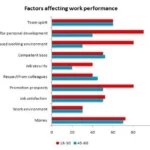IELTS Academic Writing Task 1
The bar chart below shows the results of a survey conducted by a personnel department at a major company. The survey was carried out on two groups of workers: those aged from 18-30 and those aged 45-60, and shows factors affecting their work performance.
Summarise the information by selecting and reporting the main features and make comparisons where relevant.
Things you should know about Academic Writing Task 1:
- You are asked to describe information presented in graph/ table/ chart/ diagram.
- You have 20 minutes to finish the task and you have to write at least 150 words.
- If you are asked to use the information presented in the graph you must be careful not to copy it.
In Academic Writing task 1, candidates are assessed on their ability to:
- Organise, present and possibly compare data.
- Describe the stages of a process or procedure.
- Describe an object or event or sequence of events.
- Explain how something works.
Model Answer
A bar chart shows the factors by age group that most affect job performance at a particular company.
Overall, it is clear that younger employees value more opportunities for advancement, personal development opportunities, and relaxed work environments. For both age groups, salary and team spirit were important, while work environment and job security tended to be less effective.
Looking at more similar categories, in both age groups, 60% believe team spirit is important and 30% believe their environment affects their work performance. The reported figures are job satisfaction (55% for those aged 18-30 and 50% for those aged 45-60), respect from peers (38% for younger employees) which is 4% less than the ration of older people, young people give more importance to money than an older age group (73%, and 70% respectively), and competent managers (both nearly 50%).
Only 90% of workers aged 18 to 30 and 38% of workers older have a noticeable difference in the impact of personal development opportunities on their jobs. 85% of young people expect/want a relaxed work environment, which is more than double that of adults and seniors, and job security (40% to 20%) and promotion opportunities ( 80% to about 48%).
Read More :
- The pie charts show information about energy production in a country in two separate years
- The pie charts gives information about the world’s forests in five different regions
- The graph below shows the annual visitor spend for visitors to New Zealand from 5 countries for the years 1996 to 2014
- The Chart Shows Requests for Information at a Tourist Office in the United Kingdom
- The Town of Lynnfield in 1936 and then later in 2007
- The Maps below show Pancha Village in 2005 and 2015
- The diagram below describes the structure of a home smokery and how it works
- The bar chart illustrates the percentage of businesses in the UK who had a social media presence
Factors Affecting Work Performance

A bar chart shows the factors by age group that most affect job performance at a particular company.
Overall, it is clear that younger employees value more opportunities for advancement, personal development opportunities, and relaxed work environments. For both age groups, salary and team spirit were important, while work environment and job security tended to be less effective.
Looking at more similar categories, in both age groups, 60% believe team spirit is important and 30% believe their environment affects their work performance. The reported figures are job satisfaction (55% for those aged 18-30 and 50% for those aged 45-60), respect from peers (38% for younger employees) which is 4% less than the ration of older people, young people give more importance to money than an older age group (73%, and 70% respectively), and competent managers (both nearly 50%).
Only 90% of workers aged 18 to 30 and 38% of workers older have a noticeable difference in the impact of personal development opportunities on their jobs. 85% of young people expect/want a relaxed work environment, which is more than double that of adults and seniors, and job security (40% to 20%) and promotion opportunities ( 80% to about 48%).






